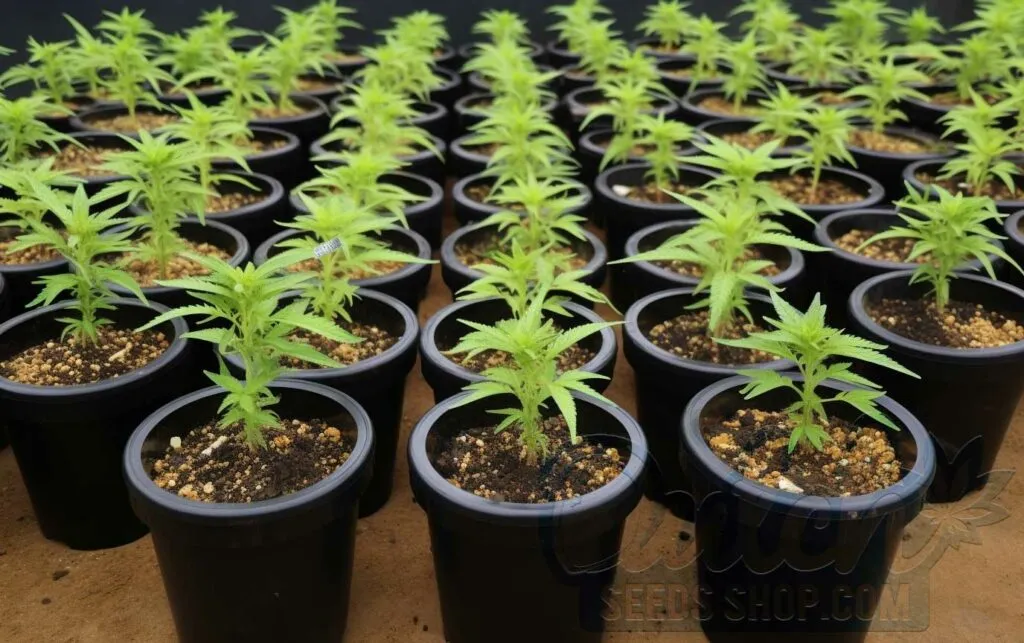How to Grow Khalifa Kush Strain
Growing Khalifa Kush, a premium cannabis strain known for its unique characteristics and therapeutic benefits, requires specific knowledge and techniques. This guide offers comprehensive insights to help both novice and experienced growers achieve optimal results.

Get To Know Khalifa Kush Strain
Khalifa Kush, a hybrid born from OG Kush, stands out due to its high THC content (24%-26%) and low CBD levels.
It’s celebrated for its earthy, lemon, pine, and pungent flavors.
The effects of Khalifa Kush are predominantly happy, relaxed, uplifted, and euphoric, making it an ideal choice for managing stress, insomnia, pain, and even depression.
| Aspect | Details |
| Lineage | OG Kush |
| THC/CBD Content | 24%-26% THC, <2% CBD |
| Flavors | Earthy, Lemon, Pine, Pungent |
| Effects | Happy, Relaxed, Uplifted, Euphoric |
| Grow Difficulty | Moderate |
| Flowering Time | 60-65 days |
| Yield | 1.4-1.8 oz/ft² (Indoor), 12-14 oz/plant (Outdoor) |
Tips and Tricks for Growing Khalifa Kush Successfully
To successfully grow Khalifa Kush, focus on its moderate growing difficulty.
The strain flourishes in a warm climate, with a medium height profile.
During the flowering phase of 60-65 days, pruning is crucial to maximize yield.
When considering Khalifa Kush seeds or clones, prioritize reputable sources to ensure plant health.
Accessories like proper lighting and nutrients are key for optimal growth.
Khalifa Kush Indoor Growing
Growing Khalifa Kush indoors requires an understanding of its unique needs and the challenges specific to indoor cultivation.
While it offers several advantages, growers must be aware of the specific requirements of this strain to achieve the best results.
Benefits of Indoor Growing

Indoor cultivation of Khalifa Kush strain presents numerous benefits.
High-quality weed is a major advantage, as indoor environments allow for greater control over factors like light, temperature, and humidity, leading to potent and aromatic buds.
Growers can also enjoy multiple harvests throughout the year, unbound by outdoor growing seasons.
The ability to control environmental factors ensures consistent quality and potency.
Furthermore, indoor growing offers enhanced privacy and security, a crucial consideration given the legal and social aspects of cannabis cultivation.
- High-quality cannabis
- Multiple harvests
- Control over growth environment
- Enhanced privacy and security
Setting Up Your Indoor Grow Space
Choosing the right space is the first step in indoor cultivation.
Options range from closets to dedicated grow tents and spare rooms.
Proper ventilation is crucial to manage the odor and provide fresh air to the plants.
Grow lights play a significant role in plant health and yield; therefore, selecting the right type is essential.
While setting up, balancing cost management and quality is key to a successful grow operation.
- Choose a suitable space (closet, tent, room).
- Ensure proper ventilation.
- Select appropriate grow lights.
- Manage setup costs effectively.
Climate Control
Climate control is vital for the successful indoor cultivation of Khalifa Kush.
Temperature and humidity levels significantly impact plant health and yield.
Utilizing devices like environmental controllers and air-cooled reflector hoods for HID lights ensures these factors stay within the ideal range.
Oscillating fans aid in maintaining air circulation, which is crucial for plant health.
Automation, through timers or controllers, can help maintain a consistent growing environment.
Types of Lights

The choice of grow lights significantly affects the Khalifa Kush’s development.
HID (High-Intensity Discharge) lights are preferred for their efficiency in both the vegetative and flowering stages.
Fluorescent lights are more suitable for smaller setups or early growth stages.
LED lights are becoming increasingly popular due to their energy efficiency and broad light spectrum.
Understanding how each type impacts the plant at different stages is crucial for optimizing growth and yield.
- HID lights for efficiency
- Fluorescent lights for small setups
- LED lights for energy efficiency
Growing Mediums and Containers
The choice between soil and hydroponics depends on the grower’s experience and the specific needs of Khalifa Kush.
Soil is more forgiving and suitable for beginners, while hydroponics can lead to faster growth and larger yields but requires more expertise.
Container choice, whether standard plastic pots or fabric containers, also impacts plant health, particularly root development and air flow.
Proper drainage is essential to prevent root rot and other issues.
Caring for Indoor-Grown Khalifa Kush
Caring for Khalifa Kush indoors involves a routine that includes regular watering with pH-balanced water and nutrient management.
The use of specific nutrient solutions tailored to the plant’s growth stage is important.
Pruning helps in managing plant size and promoting healthier buds.
Monitoring for early signs of pests and diseases is crucial for maintaining plant health.
Odor Control
Odor control is a critical aspect of indoor cultivation.
Techniques include using activated carbon filters and ensuring efficient air circulation with exhaust and intake fans.
Odor-absorbing gels can also be used to mask the cannabis aroma, especially in confined spaces.
Khalifa Kush Outdoor Growing
Outdoor cultivation of Khalifa Kush brings a different set of benefits and challenges compared to indoor growing.
This section explores the essential aspects of successfully growing Khalifa Kush outdoors, from timing and soil preparation to advanced yield-maximizing techniques.
Benefits of Outdoor Growing

Outdoor cultivation of Khalifa Kush offers several advantages.
Cost-effectiveness is a key benefit, as outdoor growing relies less on artificial lighting and climate control, reducing expenses significantly.
Larger yields are often achievable due to more space and natural resources.
This method is also environmentally sustainable, using sunlight and natural air flow.
Additionally, many growers find the therapeutic aspects of outdoor gardening enriching.
| Benefit | Description |
| Cost-Effective | Reduced reliance on artificial resources |
| Larger Yields | Natural environment supports greater growth |
| Environmental Sustainability | Uses natural resources like sunlight |
| Therapeutic | Gardening itself offers mental and physical benefits |
Best Time to Plant Khalifa Kush Outdoors
For optimal growth, the best time to plant Khalifa Kush outdoors is in the late spring, typically around April or May in the Northern Hemisphere.
This timing ensures that the plants are not exposed to late frosts and can take full advantage of the summer growing season.
Understanding the specific climate variations of your region is crucial.
Germination should ideally begin indoors, with seedlings later transplanted outdoors when they are sturdy enough to withstand external conditions.
Setting Up Outdoor Grow Spaces
Choosing the right location is crucial for the success of outdoor Khalifa Kush cultivation.
Understanding your local climate is essential to protect plants from adverse weather.
The chosen space should receive adequate sunlight—at least 6 hours a day.
Wind protection, through natural barriers or artificial structures, is also important to prevent damage to the plants.
- Assess and understand local climate conditions.
- Ensure sufficient daily sunlight exposure.
- Provide protection against strong winds.
Selecting and Preparing Soil

Soil quality significantly impacts the health and yield of Khalifa Kush.
Soil testing is recommended to understand its composition and nutrient levels.
Based on the results, amendments may be necessary to achieve the ideal balance for cannabis cultivation.
When selecting soil, consider organic or pre-fertilized options for ease and efficiency.
Ensuring the soil is rich in essential nutrients and has good drainage is key for healthy growth.
Nutrients and Fertilizers
The right balance of nutrients and fertilizers is critical for the outdoor cultivation of Khalifa Kush.
Nitrogen, phosphorus, and potassium are essential throughout its lifecycle.
The choice between organic and synthetic fertilizers depends on personal preference and the specific needs of the plants.
Proper irrigation and nutrient scheduling are crucial to avoid over or underfeeding the plants.
- Nitrogen, phosphorus, potassium
- Organic vs. synthetic options
- Irrigation and nutrient scheduling
How to Maximize Khalifa Kush Yield
Maximizing the yield of Khalifa Kush, whether grown indoors or outdoors, involves advanced cultivation techniques.
Training methods, such as topping and low-stress training, can significantly enhance plant health and yield.
Considering factors like CO2 enrichment and optimal light intensity are also important for indoor setups to boost growth and flower production.
Growing Khalifa Kush presents a blend of challenges and rewards.
Its moderate difficulty level makes it an engaging endeavor for growers looking to enhance their skills.
The unique combination of high THC content, distinctive flavors, and therapeutic effects makes mastering this strain highly rewarding.
Growers can expect not only a satisfying cultivation experience but also a potent product that stands out in both recreational and medicinal contexts.
Embracing the intricacies of Khalifa Kush growing, from careful climate control to nutrient management, offers a fulfilling journey for any cannabis cultivator, promising rich yields and a deeper appreciation for the art of cannabis cultivation.
FAQ
Can Khalifa Kush be grown in colder climates?
Khalifa Kush prefers a warm climate, but with proper care, it can be grown in cooler climates. Indoor cultivation with controlled heating and insulation is advisable in such regions.
How resistant is Khalifa Kush to pests and diseases?
Khalifa Kush exhibits moderate resistance to common pests and diseases. Implementing preventative measures and maintaining optimal growing conditions are key to keeping these issues at bay.
Is Khalifa Kush suitable for beginner growers?
Khalifa Kush has a moderate growing difficulty. While not the easiest strain for beginners, with careful research and attention to its specific needs, novice growers can successfully cultivate it.
How often should Khalifa Kush be watered?
Watering frequency depends on factors like the plant’s growth stage, climate, and growing medium. Generally, it’s important to maintain moist but not waterlogged soil, adjusting as needed.
Can Khalifa Kush be grown using organic methods?
Yes, Khalifa Kush can be grown organically. Using organic soil, natural fertilizers, and non-chemical pest control methods are effective for cultivating this strain organically.
About the Author
Share the Love:
